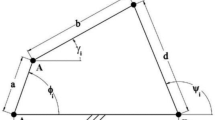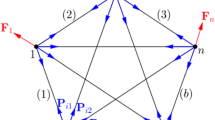Abstract
In this paper, development of shape modeling tools for engineering design, analysis, simulation, and visualization is presented. The approach based on the idea of function-based shape modeling is combined with the power and versatility of the object-oriented programming (OOP). An OOP code, initially developed as a teaching and learning tool for educational use in an undergraduate Modeling and Simulation course, to generate mechanism components is presented. Different parametric, explicit, and implicit functions or their combination are used to generate mechanical components shapes. Using a blending process, sophisticated shapes have been generated on the graphical interface. However, the ideas and concept of the OOP mechanical components design presented in this paper can be applied to other application areas.
















Similar content being viewed by others
References
Bardis L, Patrikalakis NM (1989) Blending rational b-spline surfaces. Eurographics 89:453–462
Bloomenthal J (1988) Polygonization of implicit surfaces. Comput Aided Geom Des 5(4):341–355
Bloomenthal J (eds) (1997) Introduction to implicit surfaces. Morgan Kaufmann Publishers Inc., San Francisco
Bloor MIG, Wilson MJ (1989) Generating blend surfaces using partial differential equations. Comput Aided Des 21:165–171
Campbell M, Cheng HH (2007) Teaching computer-aided mechanism design and analysis using a high-level mechanism toolkit. Comput Appl Eng Educ 15:277–288
Cartwright R, Adzhiev V, Pasko A, Goto Y, Kunii TL (2005) Web-based shape modeling with HyperFun. Computer graphics and applications, IEEE, pp 60–69
Chaikin GM (1974) An algorithm for high speed curve generation. Comput Graphics Image Process 3:346–349
Cheng HH, Trang DT (2006) Object-oriented interactive mechanism design and analysis. Eng Comput 21:237–246
Cojocaru D, Karlsson AM (2008) An object-oriented approach for modeling and simulation of crack growth in cyclically loaded structures. Adv Eng Softw 39:995–1009
Collins CL, McCarthy JM, Perez A, Su H (2002) The structure of an extensible Java applet for spatial linkage synthesis. J Comput Inf Sci Eng 2(45):45–50
de Figueiredo LH (1996) Surface intersection using affine arithmetic. In: Proceedings of graphics interface’96, pp 168–175
Dupac M (2007) Mechanism components generation and visualization using mathematical functions. In: Proceedings of the 2007 ASME early career technical conference (CD-ROM)
Dupac M, Popirlan CI (2010) Web technologies for modelling and visualization. In: Shkelzen Cakaj (ed) Mechanical engineering, modeling simulation and optimization—tolerance and optimal control. ISBN: 978-953-307-056-8, InTech
Dyn N, Levin D (2002) Subdivision schemes in geometric modeling. Acta Numer 11:73–144
Farin GE, Hoschek J, Kim M-S (2002) Handbook of computer aided geometric design. Elsevier, Amsterdam
Fayolle P-A, Schmitt B, Goto Y, Pasko A (2005) Web-based constructive shape modeling using real distance functions. IEICE Trans Inf Syst E88D(5):828–835
Fougerolle Y, Gribok A, Foufou S, Truchetet F, Abidi M (2005) Boolean operations with implicit and parametric representation of primitives using R-functions. IEEE Trans Vis Comput Graphics 11(5):529–539
Hartmann E (1995) Blending an implicit with a parametric surface. Comput Aided Geom Des 12:825–835
Hatna A, Grieve RJ, Broomhead P (2001) Surface blending for machining purposes: a brief survey and application for machining compound surfaces. J Eng Manuf 215(10):1397–1408
Hoffmann CM (1990) Algebraic and numerical techniques for offsets and blends. In: Dahmrn W, Gasca M, Micchelli CA (eds). Kluwer, Dordrecht, pp 499–528
Hoffmann C (1993) Implicit curves and surfaces in computer aided geometric design. IEEE Comput Graphics Appl 13(1):79–88
Hoschek J, Lasser D (1993) Fundamentals of computer aided geometric design. Taylor & Francis, London
Hui KC, Lai YH (2006) Smooth blending of subdivision surfaces. Comput Aided Des 38:786–799
Kromera V, Dufosseb F, Gueurya M (2005) On the implementation of object-oriented philosophy for the design of a finite element code dedicated to multibody systems. Finite Elem Anal Des 41:493–520
Larson J, Cheng HH (2000) Object-oriented cam design through the internet. J Intell Manuf 11(6):515–534
Lee T, Bedi S, Dubey RN (1993) A parametric surface blending method for complex engineering objects. In: Proceedings on the 2nd ACM symposium on solid modeling and applications, SMA ’93. ACM, New York, pp 179–188
Levinski K, Sourin A (2007) Interactive function-based shape modelling. Comput Graphics 31:66–76
Liu Q, Sourin A (2006) Function-based shape modelling extension of the Virtual Reality Modelling Language. Comput Graphics 30(4):629–645
Liu Z, Wang Z, Tan J, Fu Y, Wan C (2006) A virtual environment simulator for mechanical system dynamics with online interactive control. Adv Eng Softw 37(10):631–642
Mackie RI (2004) Extensibility of finite element class systems—a case study. Comput Struct 82(23–26):2241–2249
Metaxas D (1996) Physics-based deformable models. Kluwer, Dordrecht
Motza DS, Haghighi K (1991) A knowledge-based design model for mechanical components. Eng Appl Artif Intell 4(5):351–358
Pantale O, Caperaa S, Rakotomalala R (2004) Development of an object-oriented finite element program: application to metal-forming and impact simulations. J Comput Appl Math 168:341–351
Pasko G, Pasko A, Kunii T (2005) Bounded blending for function-based shape modeling. IEEE Comput Graph Appl 25(2):36–45
Popirlan C, Dupac M (2008) A web-based approach for 3D mechanism components modeling and visualization. In: Proceedings of the 17th IASTED international conference on applied simulation and modelling, paper no. 609-080, pp 123–129
Pratt MJ, Geisow AD (1986) Surface/surface intersection problems. In: Gregory JA (eds) The mathematics of surfaces, vol 16. Clarendon Press, Oxford, pp 117–142
Qiao H (2006) Object-oriented programming for the boundary element method in two-dimensional heat transfer analysis. Adv Eng Softw 37:248–259
Santos C (1994) Design and implementation of an object-oriented view mechanism. GOODSTEP ESPRIT–III No. 6115, GOODSTEP Technical Report No. 7, pp 1–22
Sederberg T (1983) Implicit and parametric curves and surface for computer-aided geometric design. PhD dissertation, Purdue University
Seth A, Su H-J, Vance JM (2006) SHARP: a system for haptic assembly and realistic prototyping. In: Proceedings of the DETC’06/CIE-99476, pp 1–9
Siemers A, Fritzson D (2009) Visualisation and data representation for large scale multibody simulations with detailed contact analysis: a case study. Simul Model Pract Theory 17:1130–1142
Su H, Collins C, McCarthy JM (2002) An extensible Java applet for spatial linkage synthesis. In: Proceedings of DETC2002/MECH-34371, pp 1–8
Terzopoulos D, Metaxas D (1991) Dynamic 3D models with local and global deformations: deformable superquadrics. IEEE Trans Pattern Anal Mach Intell 13:703–714
Ullman DG (1997) The mechanical design process, 2nd edn. McGraw-Hill, New York
Ünsalan C, Erçil A (2001) Conversions between parametric and implicit forms using polar/spherical coordinate representations. Comput Vis Image Underst 81(1):1–25
Woodwark JR (1987) Blends in geometric modeling. In: Martin RR (ed) The mathematics of surfaces. Oxford University Press, Oxford, pp 255–297
Woonga M, Chaa J-H, Parka J-H, Kangb M (1999) Development of an intelligent design system for embodiment design of machine tools. CIRP Ann Manuf Technol 48(1):329–332
Xue D, Yang H (2004) A concurrent engineering-oriented design database representation model. Comput Aided Des 36:947–965
Yan Y, Tan ST (2004) Adding draft angles on mechanical components containing constant radius blending surfaces. Comput Aided Des 36:565–580
Author information
Authors and Affiliations
Corresponding author
Rights and permissions
About this article
Cite this article
Dupac, M. An object-oriented approach for mechanical components design and visualization. Engineering with Computers 28, 95–107 (2012). https://doi.org/10.1007/s00366-011-0220-3
Received:
Accepted:
Published:
Issue Date:
DOI: https://doi.org/10.1007/s00366-011-0220-3




